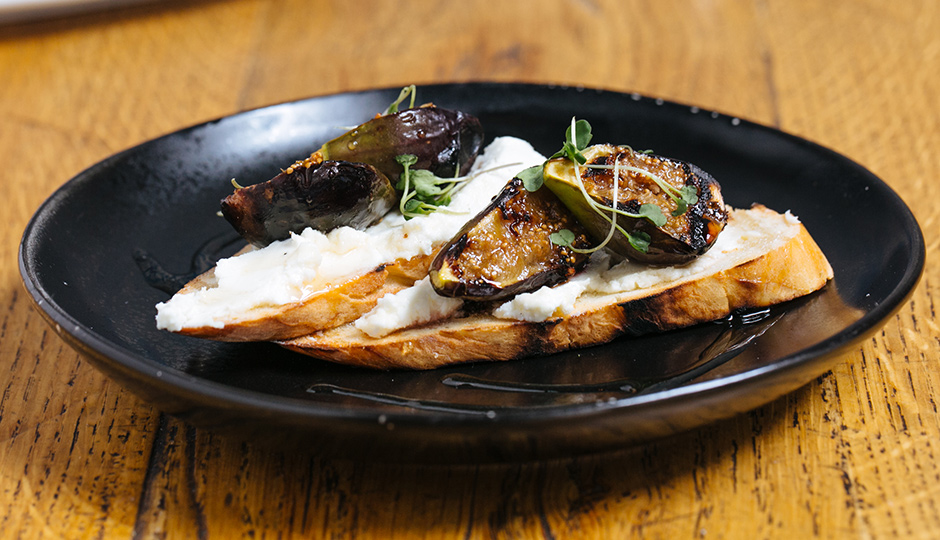The Revisit: Opa

Fig Dakos at Opa | Photo via Opa
When Opa first opened, it was loud, brash, crowded and dull. The kitchen seemed incapable of dependably executing the most basic dishes. The cooks were occasionally flummoxed by the simple interaction of meat and fire and would season things like toddlers given a spice rack to play with. I’d seen dudes in the park fresh off the spike who moved with more purpose than the floor staff on a weeknight, and the crowds that mobbed the place were a weird collection of neighborhood regulars and knots of sports-coated business bros who’d cluster like wolves at the corners of the bar, laugh too loud, and order rounds of Heineken and Amstel Light like they were on the last night of their package tour to Ibiza.
Back in the day (August 2011, to be exact), Trey Popp, Philly Mag’s restaurant critic at the time, gave the joint one-and-a-half stars, which I thought was too many by three. I hated the place pretty much unreservedly, and in the augmented-reality Terminator vision I have while clocking restaurants in this city, I always saw Opa with a big red X through it and the words AVOID AT ALL COSTS.
But that was then. A little over a year ago, Opa made some changes. They brought in a new chef, Bobby Saritsoglou, who came to Sansom Street by way of Santucci’s in Bella Vista and, before that, Greece, where he’d worked in several restaurants and, presumably, learned a little something about Greek food. Since there wasn’t much chance that he could possibly know less than the crew that had already been in place at Opa, I was intrigued.
Not enough to actually, you know, go there (a man gets only so many dinners in his life, and I wasn’t wasting another one on limp salads and pork souvlaki that tasted hauntingly of McDonald’s breakfast sausages), but enough to pay attention.
Saritsoglou slid into position behind the grills in March 2015. In April, he dropped his first redo of the menu, and it came with two big middle fingers—one for the old board at Opa, and one for the narrow notion of “traditional” Greek cuisine as nothing but flaming saganaki, stale pita and last-call plates of char-edged chicken souvlaki ordered by queasy drunks at all-night diners.
No, he was aiming for modern Greek the way that Jeremy Nolen aims for modern German at Brauhaus Schmitz—offering first a revision of expectation, then a reconsideration of technique. Saritsoglou and his kitchen broadened the flavor palette, remixing Greek, Mediterranean, French and Italian riffs, throwing down quinoa and long hots, wild boar ragu and tzatziki spiked with horseradish. He offered crab gyros with falafel spices, and buttermilk fried rabbit with coleslaw and sweet bobota cornbread. It was strange, daring, unconventional. Most important, it wasn’t dull.
Recently, Opa released the kitchen’s first serious revision of that menu. For almost a year, Saritsoglou had tinkered, making small changes until he found a sweet spot between intriguing and unrecognizable where he could comfortably hang his modern Greek cuisine. And with this newest menu (which took effect just a month ago), I finally felt like it was time to give the place another serious try. I went in early on a Thursday evening for dinner, found the bar as crowded as ever with a cacophony of bros, ordered a drink and some snacks, received a highly suspect bowl of avgolemono soup (the chicken so over-poached in the broth that it had the texture of warm gelatin) and souvlaki that looked like it’d been cooked with a blowtorch, hated everything, said fuck it, and left.

Lamb gyros | Photo via Opa
The service was better—I’ll give Opa that. And they’d added some features (like a wall of sticks that give the dining room a somewhat more rustic feel) to deal with the noise, since once upon a time, eating there was like having dinner inside a tin box lined with river stones, every sound echoing and amplified. But the kitchen, it appeared, had learned nothing, and I wanted to burn the place down on my way out.
But then, the guilt. Maybe somehow it’d been my fault. Maybe I’d ordered poorly, or caught the kitchen on a bad night. If I’d ordered more, maybe, somehow, I would’ve found what it is that Saritsoglou does well. Maybe the soup was meant to be so weirdly squishy. And anyway, it had tasted pretty good, hadn’t it? All bright with lemon and laced with the high, astringent greenness of dill.
So I went back again. And again. I kept going back until I was pretty sure that the early dinner crowds (this odd species of young-old male office drones that speaks only in acronyms and data points, that drinks only Amstel, that shouts in each other’s ears even when they’re the only ones talking and wears shoes that cost more than my nicest suit) were just actors, paid to make the bar look full and vital, like the girls in a Japanese hostess club, and knew (for sure) that yeah, the soup was made that way deliberately.
I went back and had dishes that were amazing—chicken souvlaki done properly this time, cooked beautifully, chunks of thigh meat grill-marked on their sticks, set over a smear of sticky honey mustard and scattered with bits of crispy chicken skin, and deeply marinated pork as tender as good barbecue. One of the superpowers of Greek cuisine is simplicity—the smart wedding of just two or three powerful flavors, adulterated by no fripperies—and there is very little better in this world than a ripe fig touched with nothing more than a dab of honey, unless it’s that same fig drizzled with Cretan monastiri honey and set atop a toast round smeared with whipped goat cheese.
Saritsoglou and his crew, when they’re paying attention, are capable of doing great things, balancing thoughtful presentations and traditional Greek dishes (brought up from a cultural space deeper than the one home to gyros and stuffed grape leaves) with a modern sense of internationalism. He calls his peinirli, for example, “Greek stromboli,” which is not true at all. They’re nothing like stromboli; they have more in common with Georgian khachapuri. You get a boat-shaped bread bowl, open in the center, filled with melted, gooey kefalograviera cheese and an egg, dosed hard with salt and pepper, then scattered with thick chunks of lamb bacon.
Every element of Saritsoglou’s peinirli is perfect. It’s one of the most delicious things I’ve eaten in weeks when I have it the first time, and then, even with all the anticipation, somehow better the second. The bread is golden, soft and salty. The cheese is all stretchy and crowned with the yellow, broken yolk. The lamb bacon is rich and fatty. I want it for breakfast, lunch and dinner. Writing about it now, I can still taste it, see it the way it looked when it first arrived on my table. The sensation is not all that different from first love—powerful and obsessive.
And yet, and yet … At the dinner where I had my second peinirli, I also ordered off the “Macaronia” portion of the menu—the Greek pastas—and got a shallow bowl of sheep’s-milk dumplings with green peas and wild mushrooms in a parmesan broth that was as boring and tasteless as anything I’d had under Opa’s old guard (the morel mushrooms alternately burnt or spongy, the peas dry and mealy, the broth as flavorless as lukewarm water), and a repeat plate of barley toast with fig and honey in which the figs were over-ripe, mushy, sad in their replication of something that, just a week before, had been so elementally ideal.
So here’s the deal. Opa? It can be a great restaurant when the front and back of the house are in sync—when the cooks remember what it is that makes their particular take on Greek food so good. Bobby Saritsoglou has taken a place that meant less than nothing to me and turned it into one that I can recommend (with caveats), and that’s no small trick. Restaurants don’t usually come back from Craptown that way, but he has made a menu that can surprise you like a sucker punch, the kind where brilliant moments sneak up on you from directions you never anticipated.
It’s also a restaurant suffering from a huge consistency problem, which seriously pisses me off. If not for moments of true joy (the fig toast at its best, the peinirli, souvlaki presented with all the promised elements intact), I would have gone straight back to hating the place. But the good times are just too good to ignore completely.
So go for the peinirli, for sure. Take your chances on some olives and fried artichokes with lemon aioli and salt. The dakos (barley toasts) are worth it because even when less than perfect, they’re still pretty good. And everything else? Well, that’s where you’re gambling. On a good night, the kitchen is remarkable. On a bad one, they represent the thing I hate most in this industry—true potential squandered.
2 stars – Come if you’re in the neighborhood.
Opa [Foobooz]


